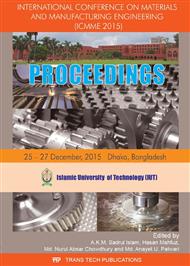[1]
K. N. Tu & K. Zeng, (2001). Tin–lead (SnPb) solder reaction in flip chip technology. Materials science and engineering: R: reports, 34(1), 1-58.
DOI: 10.1016/s0927-796x(01)00029-8
Google Scholar
[2]
C. M. Chen, K. J. Wang, & K. C. Chen, (2007). Isothermal solid-state aging of Pb–5Sn solder bump on Ni/Cu/Ti under bump metallization. Journal of alloys and compounds, 432(1), 122-128.
DOI: 10.1016/j.jallcom.2006.05.116
Google Scholar
[3]
Y. Takaku, K. Makino, K. Watanabe, I. Ohnuma, R. Kainuma, Y. Yamada & K. Ishida, (2009). Interfacial reaction between Zn-Al-based high-temperature solders and Ni substrate. Journal of Electronic Materials, 38(1), 54-60.
DOI: 10.1007/s11664-008-0528-y
Google Scholar
[4]
T. Shimizu, H. Ishikawa, I. Ohnuma, & K. Ishida, (1999). Zn-Al-Mg-Ga alloys as Pb-free solder for die-attaching use. Journal of electronic materials, 28(11), 1172-1175.
DOI: 10.1007/s11664-999-0153-4
Google Scholar
[5]
A. Haque, B. H. Lim, A. S. M. A. Haseeb & H. H. Masjuki, (2012). Die attach properties of Zn–Al–Mg–Ga based high-temperature lead-free solder on Cu lead-frame. Journal of Materials Science: Materials in Electronics, 23(1), 115-123.
DOI: 10.1007/s10854-011-0511-x
Google Scholar
[6]
M. Rettenmayr, P. Lambracht, B. Kempf, & C. Tschudin, (2002). Zn-Al based alloys as Pb-free solders for die attach. Journal of electronic materials, 31(4), 278-285.
DOI: 10.1007/s11664-002-0144-1
Google Scholar
[7]
N. Kang, H. S. Na, S. J. Kim, & C. Y. Kang, (2009). Alloy design of Zn–Al–Cu solder for ultra high temperatures. Journal of alloys and compounds, 467(1), 246-250.
DOI: 10.1016/j.jallcom.2007.12.048
Google Scholar
[8]
T. Takahashi, S. Komatsu, H. Nishikawa, & T. Takemoto, (2010). Improvement of high-temperature performance of Zn-Sn solder joint. Journal of electronic materials, 39(8), 1241-1247.
DOI: 10.1007/s11664-010-1233-1
Google Scholar
[9]
V. R. Manikam, & K. Y. Cheong, (2011). Die attach materials for high temperature applications: a review. Components, Packaging and Manufacturing Technology, IEEE Transactions on, 1(4), 457-478.
DOI: 10.1109/tcpmt.2010.2100432
Google Scholar
[10]
S. J. Kim, K. S. Kim, S. S. Kim, C. Y. Kang, & K. Suganuma, (2008). Characteristics of Zn-Al-Cu alloys for high temperature solder application. Materials transactions, 49(7), 1531-1536.
DOI: 10.2320/matertrans.mf200809
Google Scholar
[11]
T. Shimizu, H. Ishikawa, I. Ohnuma, & K. Ishida, (1999). Zn-Al-Mg-Ga alloys as Pb-free solder for die-attaching use. Journal of electronic materials, 28(11), 1172-1175.
DOI: 10.1007/s11664-999-0153-4
Google Scholar
[12]
R. H. Galib, R Al Hasan, & A. Sharif, (2016). Study of off-eutectic Zn–xMg high temperature solder alloys. Journal of Materials Science: Materials in Electronics, 27(9), 9981-9981.
DOI: 10.1007/s10854-016-5165-2
Google Scholar


